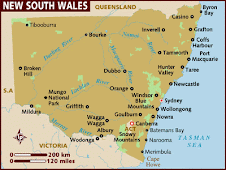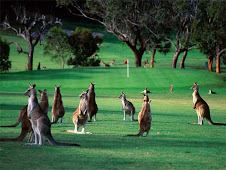Australia:History
Pre 20th Century History
Australia's original inhabitants, known as Australian Aborigines, have the longest continuous cultural history in the world, with origins dating back to the last Ice Age. Although mystery and debate shroud many aspects of Australian prehistory, it is generally accepted that the first humans travelled across the sea from Indonesia about 70,000 years ago. The first visitors, called 'Robust' by archaeologists because of their heavy-boned physique, were followed 20,000 years later by the more slender 'Gracile' people, the ancestors of Australian Aborigines.
Europeans began to encroach on Australia in the 16th century: Portuguese navigators were followed by Dutch explorers and the enterprising English pirate William Dampier. Captain James Cook sailed the entire length of the eastern coast in 1770, stopping at Botany Bay on the way. After rounding Cape York, he claimed the continent for the British and named it New South Wales.
In 1779, Joseph Banks (a naturalist on Cook's voyage) suggested that Britain could solve overcrowding problems in its prisons by transporting convicts to New South Wales. In 1787, the First Fleet set sail for Botany Bay under the command of Captain Arthur Philip, who was to become the colony's first governor. The fleet comprised 11 ships, 750 male and female convicts, four companies of marines and supplies for two years. Philip arrived in Botany Bay on 26 January 1788, but soon moved north to Sydney Cove, where there was better land and water. For the new arrivals, New South Wales was a harsh and horrible place, and the threat of starvation hung over the colony for at least 16 years.
Australia never experienced the systematic push westward that characterised the European settlement of America. Early exploration and expansion took place for one of three reasons: to find suitable places of secondary punishment, like the barbaric penal settlements at Port Arthur in Van Diemen's Land and on Norfolk Island; to occupy land before anyone else arrived; or in later years, because of the quest for gold.
Free settlers began to be attracted to Australia over the next decades, but it was the discovery of gold in the 1850s that changed the face of the colony. The huge influx of migrants and several large finds boosted the economy and irrevocably changed the colonial social structures. Aborigines were ruthlessly pushed off their tribal lands as new settlers took up land for farming or mining. The Industrial Revolution in England required plenty of raw materials, and Australia's agricultural and mineral resources expanded to meet the demand.
Modern History
Australia became a nation when federation of the separate colonies took place on 1 January 1901 (although many of the legal and cultural ties with England remained). Australian troops fought alongside the British in the Boer War and WWI. Interestingly, while Australians rallied to the aid of Britain during WWI, the majority of voters were prepared to support voluntary military service only. Efforts to introduce conscription during the war led to bitter debate, both in parliament and in the streets, and in referenda compulsory national service was rejected.
Australia was hard hit by the Depression; prices for wool and wheat - two mainstays of the economy - plunged. In 1931 almost a third of breadwinners were unemployed and poverty was widespread. Swagmen became a familiar sight, as they had been in the 1890s depression, as thousands of men took to the 'wallaby track' in search of work in the countryside. By 1933, however, Australia's economy was starting to recover, a result of rises in wool prices and a rapid revival of manufacturing.
When WWII broke out, Australian troops fought alongside the British in Europe but after the Japanese bombed Pearl Harbor, Australia's own national security finally began to take priority. Singapore fell, the northern Australian towns of Darwin and Broome and the New Guinean town of Port Moresby were bombed, the Japanese advanced southward. In appalling conditions, Australian soldiers confronted and defeated the Japanese at Milne Bay, east of Port Moresby, and began the long struggle to push them from the Pacific. Ultimately it was the USA that helped protect Australia from the Japanese, defeating them in the Battle of the Coral Sea. This event was to mark the beginning of a profound shift in Australia's allegiance away from Britain and towards the USA.
Post-WWII immigration brought a flood of European immigrants, many of them non-British. The immigrants have since made an enormous contribution to the country, enlivening its culture and broadening its vision. The post-war era was a boom time in Australia as its raw materials were once again in great demand.
In the 1950s Australia came to accept the American view that it was not so much Asia but communism in Asia that threatened the increasingly Americanised Australian way of life. Accordingly, Australia followed the USA into the Korean War, and in 1965, Australia committed troops to assist the USA in the Vietnam War, though support for involvement was far from absolute. Still more troubling for many young Australian men was the fact that conscription was introduced in 1964, and those undertaking national service could now be sent overseas. By 1967 as many as 40% of Australians serving in Vietnam were conscripts.
The civil unrest aroused by conscription was one factor that contributed to the 1972 rise to power of the Australian Labor Party, under the leadership of Gough Whitlam. The Whitlam government withdrew Australian troops from Vietnam, abolished national service and higher-education fees, instituted a system of free and universally available health care, and supported land rights for Aboriginal people.
The government, however, was hampered by a hostile Senate and by much talk of mismanagement. On 11 November 1975, the governor general (the British monarch's representative in Australia) took the unprecedented step of dismissing the parliament and installing a caretaker government led by the leader of the opposition Liberal Party, Malcolm Fraser. Labor supporters were appalled - the powers that the governor general had been able to invoke had long been regarded by many as an anachronistic vestige of Australia's now remote British past. Nevertheless, it was a conservative Liberal and National Country Party coalition that won the ensuing election. A Labor government was not returned until 1983, when a former trade union leader, Bob Hawke, led the party to victory.
Recent History
After a period of recession and high unemployment in the early 1990s, the electorate eventually lost faith in the Labor government, and in early 1996, Labor leader Paul Keating was defeated in a landslide victory to the conservative coalition, led by John Howard. Howard has since become the country's second-longest serving prime minister, most recently re-elected in 2004. Under Howard, the prominent, divisive issues of refugees (and refugee camps) has seen the majority of Australians hardening their hearts to asylum seekers. At the same time, Howard's stance on Aboriginal issues has been marked more by confrontation than by sympathy.
The issue of republicanism - replacing Britain's queen with an Australian president as head of state - dominated Australian politics in the late 1990s. An increasing number of people, particularly young Australians, felt that constitutional ties with Britain were no longer relevant and the only way forward was to declare Australia a republic. However, a national referendum in 1999 resulted in a comprehensive victory for the status quo.
The country is closer than ever to the USA, as it demonstrated by its commitment to the war in Iraq (2003-). Some say that this alliance protects Australia's independence; others insist that it reduces Australia to a fawning 'client state'.





